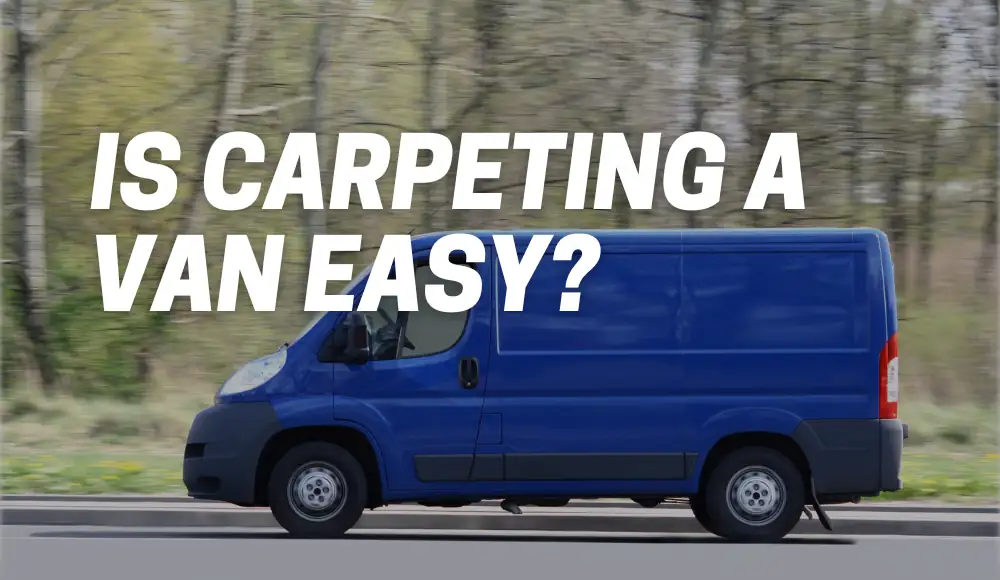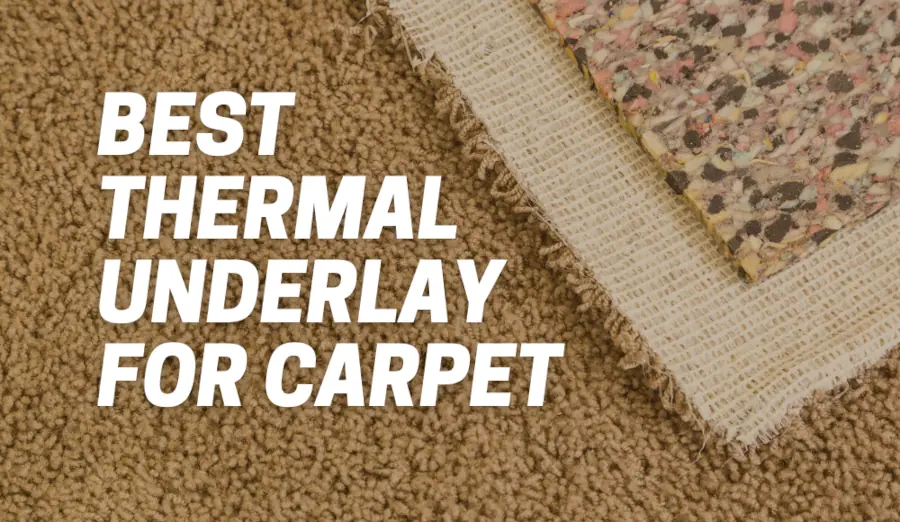Carpeting a camper van can transform it into a cozy and comfortable home away from home. It not only enhances the aesthetic appeal of the interior but also provides insulation and soundproofing. If you’re considering carpeting your van, you might have a few questions swirling in your mind. In this article, we’ll answer some main concerns regarding “Is carpeting a van easy or not?” and explore everything you need to know about camper van carpeting, including alternative options, best materials, installation tips, and more.
So, let’s dive right in!
What can I use instead of carpet in a campervan?
When it comes to lining your campervan, carpet is a popular choice due to its softness and warmth.
However, if you’re looking for alternatives to carpet, there are a few options worth considering:
- Vinyl Flooring: Vinyl flooring is a durable and waterproof option that can withstand the rigors of van life. It’s easy to clean and maintain, making it ideal for adventurers who frequently encounter dirt and moisture.
- Rubber Matting: Rubber mats provide excellent protection against spills and stains. They are easy to install and offer a non-slip surface, which is especially useful if you engage in outdoor activities and bring muddy gear into your van.
- Cork Flooring: Cork flooring is a sustainable and eco-friendly choice for campervans. It offers insulation, is comfortable underfoot, and has natural anti-microbial properties. Additionally, cork is an excellent sound absorber, reducing noise from outside the van.
What is the best material to line a van?
Choosing the right material to line your van depends on your specific needs and preferences. Here are a few popular options:
- Plywood: Plywood is a versatile and cost-effective choice for van lining. It provides a solid base for attaching fixtures and fittings, and it’s easy to work with. However, keep in mind that plywood alone won’t offer insulation or soundproofing.
- Insulation Boards: Insulation boards, such as polystyrene or polyisocyanurate (PIR), are excellent choices for enhancing thermal efficiency. These boards help regulate temperature inside the van, keeping it warm in cold weather and cool in hot climates.
- Lining Carpet: Lining carpet is specifically designed for van interiors. It offers a soft and comfortable surface while providing insulation and soundproofing. Lining carpet is available in various thicknesses and colors, allowing you to customize the look and feel of your camper van.
But what about specifically the carpet options for a van?
What is the best carpet for an RV?
Choosing the right carpet for your RV involves considering factors like durability, ease of cleaning, and aesthetics. Here are a few options worth exploring:
Different types of carpeting materials
When choosing the right carpet for your van, there are a few different types of materials to consider. The most common materials used for van carpets are nylon, olefin, and polyester.
- Nylon is the most popular choice as it is durable and stain-resistant, making it great for high-traffic areas.
- Olefin is another popular choice because it is highly resistant to moisture and mold and has a low price point.
- Polyester is also an option but isn’t as durable as nylon or olefin. It’s important to keep in mind that the quality of the carpet will affect its durability.
If you plan on using your van frequently or for extended periods, investing in a higher-quality carpet will be worth it in the long run.
However, if you’re only planning on using your van occasionally or for short trips, a lower-quality carpet may suffice.
Pros and cons of each type
Nylon carpets are an excellent choice due to their durability and resistance to stains. They also come in a variety of styles and colors giving you more options when selecting the perfect fit for your van.
However, with these benefits comes a higher price point compared to other options.
Olefin carpets have become increasingly popular due to their resistance to moisture and mold growth – perfect for those who live in damp climates or take frequent trips near water sources such as lakes or rivers.
But while they’re affordable compared to other options, they tend not to be as soft.
Polyester can be less expensive than nylon but doesn’t offer much else in terms of benefits except being machine washable which could save money on cleaning costs over time. It isn’t recommended if you’re planning on using your van frequently due to its lackluster durability compared with other options either.
Can you replace carpet in an RV?
Yes, you can replace the carpet in an RV.
Over time, carpets can become worn, stained, or outdated. By replacing the carpet, you can refresh the interior of your RV and create a more inviting space.
When replacing the carpet, it’s essential to properly measure the area and choose a suitable carpet material that can withstand the demands of RV living.
Replacing carpet in an RV
—
How much carpet is needed to carpet a van?
The amount of carpet you’ll need to carpet a van depends on the size and layout of your van.
Start by measuring the floor area you wish to cover, including any wheel arches or protrusions. It’s a good idea to add a little extra to account for any errors or to accommodate for the curvature of the van walls.
Typically, you can purchase carpet in rolls or by square foot, so make sure to calculate the total area and consult with the supplier to determine the appropriate quantity.
How much carpet is needed to carpet a VW T6 Transporter
—
Camper van carpet lining cost
The cost of camper van carpet lining can vary depending on several factors, such as the size of the van, the quality of the carpet, and the complexity of the installation.
On average, you can expect to spend between $300 and $800 for materials and installation. Keep in mind that this estimate may vary, so it’s best to obtain quotes from different suppliers or professionals to get an accurate cost assessment for your specific project.
VW Transporter van carpet lining cost
The cost of carpet lining for a VW Transporter van can also vary based on similar factors as mentioned earlier.
However, due to the popularity and availability of VW Transporter conversions, there are specialized conversion companies that offer pre-cut carpet lining kits tailored to the specific van model. These kits can range from around $500 to $1,000, depending on the quality and customization options.
In addition, here is what VW van owners share from their experience regarding carpeting the van (keep in mind that the prices may vary in your location and other aspects):
| Cost |
|---|
| About $600 for insulation, new ply panels, ceiling lights, and carpet lining |
| Received a quote of $1400 + VAT for the same services [The user is located in the UK] |
| Spent more than $600 on materials for insulation and carpeting |
| Spent less than $150 on materials for carpeting, including glue, carpet, fixings, and ply |
How to install carpet in a van
Installing carpet in a van requires careful planning and attention to detail.
Here is a step-by-step guide to help you with the installation process:
- Prepare the Van: Remove any existing flooring or debris from the van. Clean the floor thoroughly and ensure it is dry before proceeding.
- Measure and Cut: Measure the dimensions of the van floor and transfer those measurements onto the carpet. Use a sharp utility knife to cut the carpet according to the measurements, taking into account any protrusions or curves.
- Apply Adhesive: Apply a suitable carpet adhesive to the van floor. Follow the manufacturer’s instructions for proper application. It’s advisable to work in small sections to ensure the adhesive doesn’t dry before the carpet is laid.
- Lay the Carpet: Carefully lay the carpet onto the adhesive, starting from one end and working your way towards the other. Smooth out any wrinkles or air bubbles as you go, ensuring a tight and seamless fit.
- Trim and Finish: Once the carpet is in place, use a trim knife to trim any excess carpet around the edges and openings, such as doors and windows. Install any necessary trim or molding to give the carpeted area a polished look.
Remember, if you’re unsure about the installation process, it’s always recommended to consult with a professional or seek guidance from experienced individuals.
Installing a 4-Way Stretch Carpet Lining in the Van
—
How do you carpet around a van door?
Carpeting around a van door requires precision and attention to detail. Here’s a simple method to help you carpet around a van door:
- Remove Door Trim: Start by carefully removing the door trim or molding. This will allow you to tuck the carpet underneath and create a neat finish.
- Measure and Cut: Measure the dimensions of the door frame and transfer those measurements onto the carpet. Cut the carpet to fit the door area, making sure to leave a slight overlap for a seamless appearance.
- Apply Adhesive: Apply adhesive to the door frame, ensuring proper coverage. It’s best to use a spray adhesive or a brush-on adhesive for this purpose.
- Attach the Carpet: Carefully press the carpet onto the adhesive, starting from one corner and working your way around the door frame. Smooth out any wrinkles or air bubbles as you go.
- Reinstall Door Trim: Once the carpet is securely in place, reinstall the door trim or molding to cover the edges and create a finished look.
—
How to carpet a van roof
Carpeting the van roof can add a cozy touch to the interior and provide additional insulation. Here’s a general process for carpeting a van roof:
- Prepare the Roof: Clean the van roof thoroughly, removing any dirt or debris. Ensure the surface is dry before proceeding.
- Measure and Cut: Measure the dimensions of the van roof and transfer those measurements onto the carpet. Cut the carpet to fit the roof area, allowing for a slight overlap.
- Apply Adhesive: Apply a suitable adhesive to the van roof, following the manufacturer’s instructions. Work in small sections to ensure the adhesive remains workable.
- Attach the Carpet: Carefully place the carpet onto the adhesive, starting from one end and working your way across the roof. Smooth out any wrinkles or bubbles as you go, ensuring a tight and even fit.
- Trim and Finish: Once the carpet is in place, trim any excess material around the edges and openings, such as vents or lights. Install any necessary trim or molding for a polished appearance.
How to carpet around van windows
Carpeting around van windows requires precision and attention to detail. Here’s a method to help you carpet around van windows:
- Remove Window Trim: Start by carefully removing the window trim or molding. This will allow you to tuck the carpet underneath and create a neat finish.
- Measure and Cut: Measure the dimensions of the window frame and transfer those measurements onto the carpet. Cut the carpet to fit the window area, leaving a slight overlap for a seamless appearance.
- Apply Adhesive: Apply adhesive to the window frame, ensuring proper coverage. Use a suitable adhesive recommended for the specific materials involved.
- Attach the Carpet: Carefully press the carpet onto the adhesive, starting from one corner and working your way around the window frame. Smooth out any wrinkles or air bubbles as you go.
- Reinstall Window Trim: Once the carpet is securely in place, reinstall the window trim or molding to cover the edges and create a finished look.
—
How do you carpet a van wheel arch?
Carpeting a van wheel arch requires careful consideration of the shape and contours. Here’s a general approach to carpeting a van wheel arch:
- Measure and Cut: Measure the dimensions of the wheel arch area and transfer those measurements onto the carpet. Cut the carpet to fit the wheel arch, allowing for a slight overlap.
- Attach the Carpet: Using an appropriate adhesive, carefully press the carpet onto the wheel arch, starting from one end and working your way around. Take your time to ensure a snug fit and smooth out any wrinkles or bubbles.
- Trim and Finish: Once the carpet is in place, trim any excess material and ensure the edges are neatly tucked in or covered with trim for a clean and finished appearance.
—
FAQs
Can you screw into the floor of a van?
Yes, you can screw into the floor of a van, especially when installing fixtures, fittings, or securing the subflooring.
However, it’s important to be mindful of the van’s structure and potential wiring or piping underneath the floor. To avoid damaging any essential components, it’s advisable to consult vehicle-specific guidelines or seek professional assistance before proceeding with drilling or screwing into the floor.
Conclusion
Carpeting a van can be a rewarding DIY project that enhances the comfort and aesthetics of your camper. By exploring different carpet options, understanding installation techniques, and considering alternatives, you can transform your van into a cozy and inviting space.
Whether you choose carpet, vinyl flooring, or other materials, the key is to create a space that reflects your personal style and caters to your travel needs.
So go ahead, unleash your creativity, and make your camper van a home on wheels!


